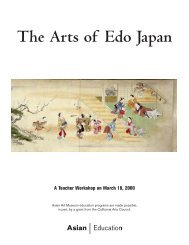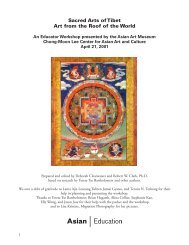Teacher Packet: Chinese Brushpainting (.pdf) - Asian Art Museum ...
Teacher Packet: Chinese Brushpainting (.pdf) - Asian Art Museum ...
Teacher Packet: Chinese Brushpainting (.pdf) - Asian Art Museum ...
You also want an ePaper? Increase the reach of your titles
YUMPU automatically turns print PDFs into web optimized ePapers that Google loves.
Slide 18<br />
Brushstrokes: Styles and Techniques of <strong>Chinese</strong> Painting<br />
Landscape<br />
sign and seals of Ike Taiga (1723-1776)<br />
Japan, Edo period<br />
One panel from a six-fold screen, ink and colors on paper<br />
B65 D51<br />
Another wave of <strong>Chinese</strong> influence washed over Japan in the 17th and<br />
18th centuries as the Manchus invaded China, sending many <strong>Chinese</strong><br />
scholars to seek refuge to Japan. They brought with them the literary<br />
man's style of painting along with a book in which were compiled<br />
examples of the methods for painting in this manner. The Mustard<br />
Seed Garden Manual of Painting was to become a primary source of<br />
inspiration for a new generation of Japanese painters. The Japanese<br />
called this style of painting nanga, or Southern School, referring to<br />
<strong>Chinese</strong> literati painting.<br />
This painting, along with five others mounted side by side to form a<br />
folding screen, explores a variety of rock and mountain texture strokes<br />
as well as foliage patterns for trees. Whereas the variety of strokes was<br />
originally developed to recreate the geological and botanical richness of<br />
nature, here the patterns become artistic ends in themselves. Ike Taiga<br />
has taken motifs from the Mustard Seed Garden Manual and used them as building blocks to construct<br />
imaginary landscapes, with little reference to actual scenery. At first glance the landscape seems<br />
reasonable but upon further scrutiny it is obvious that the parts do not cohere into a plausible landscape.<br />
The right hand mountain mass floats precariously in the mists. The flat shore joins the middle<br />
of the foreground mass, not its base. The foreground mountain mass is odd in that it is so very close<br />
to the picture surface and yet the viewer is level with its top.<br />
Where is the viewer with respect to these mountains? How do the forms relate to each other? These<br />
problems with spatial relationships are not of concern to Taiga; his interest was in pattern and design.<br />
In the Mustard Seed Garden Manual he saw not translations of reality but a collection of stimulating<br />
patterns to be arranged in almost arbitrary fashion to construct abstractions of the natural world. His<br />
use of the book in this way can be understood in light of Japanese aesthetics which tends to flatten<br />
and dematerialize form, to use elements to create a harmonious surface pattern rather than to recreate<br />
reality. This natural tendency was reinforced by the very nature of the manual. The recreation of<br />
the original painted examples of texture strokes and foliage patterns into printed woodblock versions<br />
tended to flatten the forms, especially where background color was added. These distortions produced<br />
by printing are clearly seen in Taiga's trees with their overlapping balls of foliage.<br />
Ike Taiga was a poor farm boy from the outskirts of Kyoto. Recognized as a child prodigy by the<br />
Zen monks of Mampuku Temple, he was given his first instruction in calligraphy and painting there.<br />
He also studied Japanese painting styles. At the age of 14 he opened a fan shop in Kyoto to support<br />
himself and his widowed mother, using the fashionable new nanga designs on his fans.<br />
23 <strong>Asian</strong> <strong>Art</strong> <strong>Museum</strong>
















